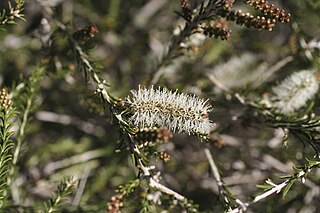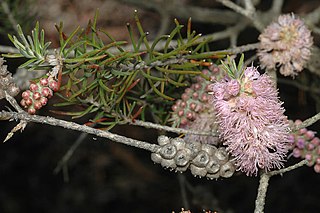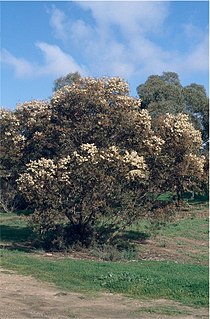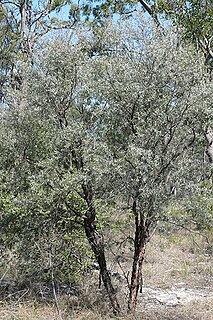
Eucalyptus erythronema, commonly known as the red-flowered mallee, is a species of mallee or tree and is endemic to Western Australia. It has smooth, dark pink to red bark that is shed to reveal whitish bark, and has lance-shaped adult leaves, pendulous flower buds mostly arranged in groups of three, red or yellow flowers and conical fruit.

Darwinia leiostyla is an erect shrub in the family Myrtaceae and is endemic to the south-west of Western Australia. It typically grows to a height of 0.3–1.5 m and has linear leaves up to about 10 mm (0.39 in) long crowded along the branches. Pendent, bell-shaped, flower-like inflorescences appear from May to January. These are clusters of small flowers surrounded by larger pink, red or white, petal-like bracts.

Leptospermum trinervium, commonly known as flaky-barked tea-tree, slender tea-tree or paperbark tree, is a species of shrub or small tree that is endemic to eastern Australia. It has papery bark that is shed in thin, flaking layers, narrow elliptic to broadly egg-shaped leaves with the narrower at the base, white flowers and silky-hairy fruit that falls from the plant when mature.

Verticordia fastigiata, commonly known as mouse featherflower, is a flowering plant in the myrtle family, Myrtaceae and is endemic to the south-west of Western Australia. It is a prostrate or low shrub with small, club-shaped leaves and mouse-scented flowers which vary in colour from golden-yellow and orange to dark red.

Melaleuca adnata, commonly known as sandhill honey-myrtle, is a plant in the myrtle family, Myrtaceae and is endemic to the south-west of Western Australia. It is a tall shrub with papery bark and spikes of white flowers in spring and early summer.

Melaleuca laxiflora, commonly known as narrow-leaved paperbark, is a woody, spreading shrub in the myrtle family, Myrtaceae and is endemic to the south-west of Western Australia. It is distinguished by its loosely arranged, mostly lateral pink flower spikes and its smooth, fleshy, oil-dotted leaves. It is often cultivated because of its hardiness and attractive flowers.
Melaleuca depauperata is a shrub in the myrtle family, Myrtaceae and is endemic to the south-west of Western Australia. It has small, fleshy leaves and purple to pink flowers on short stalks along the branches.

Melaleuca rigidifolia is a shrub in the myrtle family Myrtaceae, endemic to the south of Western Australia. It is similar to Melaleuca plumea with its pink or purple flowers but is distinguished from that species by its lack of fluffy hairs on the flowers and its spherical clusters of fruits.

Melaleuca subfalcata is a shrub in the myrtle family Myrtaceae, and is endemic to the south of Western Australia. It has fibrous bark and pink to purple flowers in spikes, mostly on the side branches.

Eucalyptus calycogona, commonly known as the gooseberry mallee or square fruited mallee, is a mallee that is endemic to southern Australia. It has smooth bark, narrow lance-shaped adult leaves, flower buds that are square in cross-section arranged in groups of seven in leaf axils, creamy white, sometimes pink flowers, and fruit that are square in cross-section.

Verticordia oxylepis, commonly known as bonsai featherflower, is a flowering plant in the myrtle family, Myrtaceae and is endemic to the south-west of Western Australia. It is a small shrub, often with a layered appearance, small leaves and very small yellow and pink flowers.

Beaufortia puberula, commonly known as hairy-leaved beaufortia, is a plant in the myrtle family, Myrtaceae and is endemic to the south-west of Western Australia. It is a shrub growing to a height of about 2 m (7 ft) with hairy young leaves and heads of hairy, pink or red flowers during most of the year.

Eucalyptus celastroides, commonly known by the Noongar name of mirret, is a species of eucalypt that is endemic to the south-west of Western Australia. It is a mallee, rarely a tree, and has rough bark on about half of the lower half of its tunk, smooth above, narrow lance-shaped adult leaves, flower buds in groups of seven or nine, white flowers and urn-shaped fruit.

Conothamnus aureus is a member of the family Myrtaceae and is endemic to Western Australia. It is a spindly, straggly shrub with rigid, blunt leaves and spherical heads of golden yellow flowers resembling those of wattles.

Leptospermum incanum is a species of compact shrub that is endemic to Western Australia. It has hairy young stems, elongated egg-shaped leaves on a short petiole, relatively large white or pink flowers and fruit that fall from the plant when mature.

Leptospermum oligandrum is a species of erect, spreading shrub that is endemic to the south-west of Western Australia. It has broadly egg-shaped to wedge-shaped leaves, white flowers arranged singly or in groups of up to three on the ends of short side branches and fruit that fall from the plant shortly after the seeds are released.
Leptospermum roei is a species of spreading shrub that is endemic to the southwest of Western Australia. It has thin, fibrous bark, long egg-shaped to narrow wedge-shaped leaves, white or pink flowers and small fruit that are shed with the seeds.

Leptospermum lamellatum is a species of shrub or small tree that is endemic to inland Queensland and has distinctive reddish, layered bark. It has narrow elliptical leaves, white flowers and small fruit that fall from the plant when mature.

Leptospermum namadgiense is a species of small shrub that is endemic to areas near the border between New South Wales and the Australian Capital Territory. It has silky-hairy, narrow lance-shaped to elliptical leaves, usually white flowers borne singly or in pairs on short side shoots, and fruit that falls from the plant shortly after the seeds are released.

Leptospermum sericatum is a species of erect shrub that is endemic to Queensland. It has thin, firm bark, narrow egg-shaped to elliptical leaves, white or pink flowers arranged usually singly on side shoots and fruit that falls from the plant when the seeds are released.

















